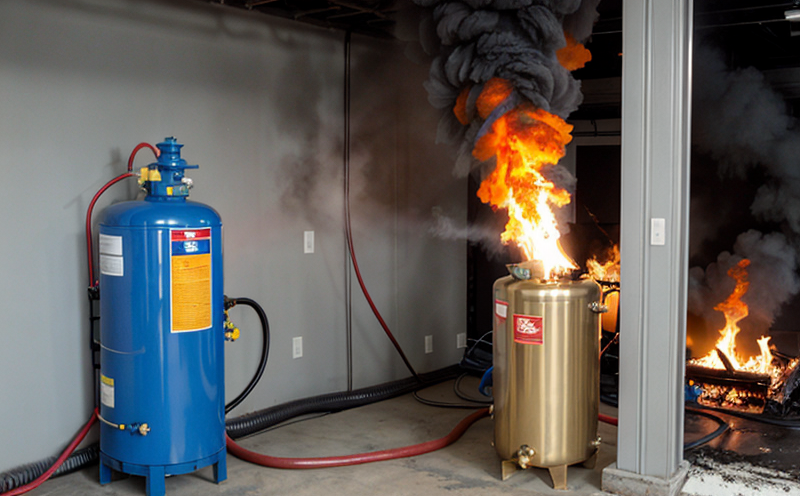EN 15004 Fixed Firefighting Systems – Gaseous Agents Testing
The European Standard EN 15004 sets stringent requirements for the design, installation, and testing of fixed firefighting systems utilizing gaseous agents. This standard is crucial in ensuring that these systems are reliable and effective in fire suppression scenarios.
Fixed firefighting systems using gaseous agents are designed to protect critical infrastructure such as data centers, oil refineries, and high-value facilities. The primary function of these systems is to extinguish fires by displacing oxygen from the combustion area or by chemically interrupting the fire triangle (fuel, heat, and oxygen). The standard covers various types of gaseous agents including halons, inert gases like argon and nitrogen, and newer alternatives such as carbon dioxide.
The testing process for EN 15004 is comprehensive and involves multiple stages to ensure the system's effectiveness. Initial testing includes static tests on the piping network, which checks for leaks and proper sealing of connections. Dynamic tests are then conducted in a controlled environment where the system is simulated under actual fire conditions.
The standard specifies precise acceptance criteria that include both quantitative measures such as pressure drop across components and qualitative assessments like visual inspections of system integrity. The goal is to ensure that these systems not only meet but exceed expectations for safety and performance.
For quality assurance, the testing process involves detailed documentation and reporting. This includes logbooks detailing all test activities, results of static tests, dynamic performance data, and any modifications made during installation or testing phases. The aim is to provide comprehensive evidence that supports compliance with EN 15004 standards.
Real-world applications highlight the importance of this standard in high-risk environments where failure can have catastrophic consequences. For instance, a data center may rely on an inert gas system to protect against fires caused by overheating servers or electrical faults. The testing process ensures that such systems are robust enough to handle real-world scenarios without compromising safety.
In summary, EN 15004 is essential for ensuring the reliability and effectiveness of gaseous agent-based fixed firefighting systems. By adhering to this standard, facilities can significantly enhance their fire protection capabilities, thereby safeguarding valuable assets and personnel.
Scope and Methodology
The scope of EN 15004 encompasses the design, installation, and testing of fixed firefighting systems that utilize gaseous agents. The standard aims to ensure these systems are reliable and effective in suppressing fires within various critical facilities.
- Static Tests: These tests check for leaks and proper sealing of connections within the piping network.
- Dynamic Tests: Simulated fire conditions are used to assess the system's performance under real-world scenarios.
- Acceptance Criteria: Both quantitative measures (pressure drop, temperature levels) and qualitative assessments (visual inspections).
The methodology for EN 15004 involves a multi-step process that begins with initial static tests to ensure the piping network is leak-free. Following this, dynamic tests are conducted where the system is simulated under actual fire conditions to evaluate its effectiveness.
Acceptance criteria play a critical role in determining whether a system meets the standards set by EN 15004. These criteria include both quantitative measures such as pressure drop across components and qualitative assessments like visual inspections of system integrity. The goal is to ensure that these systems not only meet but exceed expectations for safety and performance.
By adhering strictly to this methodology, facilities can significantly enhance their fire protection capabilities, thereby safeguarding valuable assets and personnel.
Quality and Reliability Assurance
The quality assurance process for EN 15004 is rigorous and involves multiple layers of checks to ensure the reliability and effectiveness of fixed firefighting systems. The first layer includes initial static tests on the piping network, which are conducted to check for leaks and proper sealing of connections.
Following this, dynamic tests are performed in a controlled environment where the system is simulated under actual fire conditions. These tests are designed to evaluate the system's performance and ensure that it functions as intended during critical moments.
The acceptance criteria for EN 15004 include both quantitative measures such as pressure drop across components and qualitative assessments like visual inspections of system integrity. The goal is to provide comprehensive evidence that supports compliance with the standard.
Regular inspections and tests are crucial in ensuring ongoing compliance with EN 15004. This process involves detailed documentation and reporting, including logbooks that detail all test activities, results of static and dynamic tests, and any modifications made during installation or testing phases.
By adhering to these stringent procedures, facilities can significantly enhance their fire protection capabilities, thereby safeguarding valuable assets and personnel. The comprehensive nature of the testing process ensures that only reliable systems are put into operation, providing peace of mind for all stakeholders involved.
Environmental and Sustainability Contributions
The use of fixed firefighting systems in gaseous agents plays a crucial role in environmental protection by minimizing the spread of fires and preventing catastrophic failures. These systems are designed to protect critical infrastructure such as data centers, oil refineries, and high-value industrial complexes.
By adhering to EN 15004 standards, facilities can significantly enhance their fire protection capabilities, thereby safeguarding valuable assets and personnel in high-risk environments. This compliance not only ensures the safety of workers but also contributes positively to environmental sustainability by minimizing potential damage to the environment.
The testing process for these systems is comprehensive and involves multiple layers of checks to ensure reliability and effectiveness. The first layer includes initial static tests on the piping network, which are conducted to check for leaks and proper sealing of connections. Following this, dynamic tests are performed in a controlled environment where the system is simulated under actual fire conditions.
The acceptance criteria for EN 15004 include both quantitative measures such as pressure drop across components and qualitative assessments like visual inspections of system integrity. The goal is to provide comprehensive evidence that supports compliance with the standard, thereby ensuring the reliability and effectiveness of these systems.





